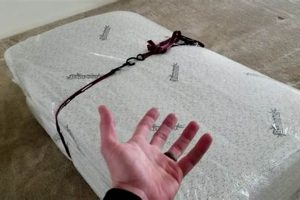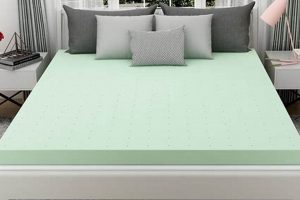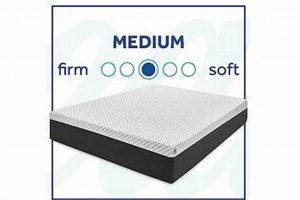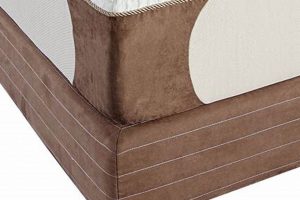The duration required for a memory foam mattress to fully reach its intended size and firmness after being unpacked is a critical factor affecting initial comfort and long-term performance. Most mattresses of this type are compressed and rolled for convenient shipping, and they need time to decompress and allow the foam cells to regain their original shape. The amount of time needed varies based on factors such as foam density, thickness, and the manufacturing process.
Allowing adequate time for this expansion is crucial for several reasons. It ensures the mattress provides the correct level of support and pressure relief, maximizing its intended benefits for spinal alignment and sleep quality. Premature use before complete expansion can lead to uneven wear, reduced lifespan, and a less comfortable sleep surface. Historically, the need for this expansion period was not always clearly communicated, leading to customer dissatisfaction.
Therefore, understanding the recommended timeframe, the environmental influences, and indicators of full expansion are essential considerations for optimizing the sleep experience with a new memory foam mattress. Specific guidance regarding these aspects is detailed in the following sections.
Guidance on Mattress Decompression Time
Optimizing the expansion process of a newly unpacked memory foam mattress ensures its longevity and performance. Adhering to the following suggestions facilitates proper decompression:
Tip 1: Review the manufacturer’s instructions. This is the primary source for specific recommendations regarding the necessary timeframe for complete decompression. Disregarding these guidelines may compromise the mattress’s integrity.
Tip 2: Provide adequate ventilation. Unpacking the mattress in a well-ventilated room assists in the dissipation of residual manufacturing odors and promotes faster expansion of the foam. Open windows and utilize fans to improve air circulation.
Tip 3: Monitor mattress dimensions. Measure the mattress dimensions at regular intervals after unpacking. Compare these measurements to the manufacturer’s stated specifications to ascertain the progress of the expansion process.
Tip 4: Consider room temperature. Higher room temperatures generally facilitate faster decompression. Maintaining a consistently warm environment can expedite the process, whereas excessively cold temperatures may impede it.
Tip 5: Exercise patience. While some mattresses may appear fully expanded within 24 hours, allowing a full 72 hours is often necessary for complete decompression, particularly for denser foam mattresses. Refrain from using the mattress until it reaches its specified dimensions.
Tip 6: Rotate the mattress (if applicable). If the manufacturers instructions indicate that the mattress can be rotated, doing so after the initial decompression period may assist in promoting even wear and prevent sagging over time.
Proper decompression, facilitated by these steps, optimizes the mattress’s ability to conform to the body, alleviate pressure points, and promote restful sleep. Neglecting these guidelines may negatively affect the mattress’s performance and longevity.
Implementing these strategies ensures the mattress’s optimal performance and extends its lifespan, promoting a superior sleep experience.
1. Manufacturer's instructions
The manufacturer’s provided guidelines serve as the definitive source for determining the appropriate decompression timeframe for a memory foam mattress. These instructions are tailored to the specific composition and construction of each mattress model, offering essential guidance for optimal performance.
- Composition-Specific Timelines
Mattress manufacturers possess detailed knowledge of the foam density, layer arrangement, and compression ratios used in their products. This expertise allows them to prescribe precise expansion times, reflecting the unique characteristics of each mattress model. Deviations from these timelines may compromise the integrity and comfort of the mattress.
- Warranty Compliance
Adherence to the manufacturer’s instructions is often a prerequisite for warranty validation. Failure to follow recommended procedures can void the warranty, leaving the consumer liable for potential defects or performance issues that may arise from improper initial setup.
- Environmental Considerations
Manufacturers may incorporate considerations for varying environmental conditions, such as temperature and humidity, into their expansion guidelines. Instructions might specify adjustments to the timeframe based on these factors to ensure proper decompression across diverse climates.
- Specialized Features and Technologies
If a mattress incorporates specialized features, such as gel infusions or zoning technologies, the manufacturer’s instructions will address the potential impact on the expansion process. Specific handling or expansion times may be necessary to accommodate these features and ensure their proper function.
Ultimately, prioritizing the manufacturer’s instructions is paramount for achieving the intended comfort and support characteristics of a memory foam mattress. These instructions provide a roadmap for proper decompression, safeguarding the consumer’s investment and maximizing sleep quality.
2. Foam density
Foam density, measured in pounds per cubic foot (lbs/ft), significantly influences the decompression timeframe required for a memory foam mattress. Higher density foams inherently possess a more compact cellular structure. This increased density presents a greater resistance to expansion after compression during the manufacturing and shipping processes. Consequently, mattresses composed of higher density foam require a longer period to fully recover their intended shape and firmness.
A mattress with a density of 5 lbs/ft may require a minimum of 72 hours to fully expand, whereas a lower density foam of 3 lbs/ft might only need 24-48 hours. The increased material packed into a smaller volume in higher density foams necessitates more time for air to permeate the structure and allow the foam cells to regain their original configuration. Premature use of a higher density mattress before complete expansion can lead to uneven support and potentially shorten the lifespan of the product, preventing the foam from reaching its full structural potential.
In summary, foam density is a critical determinant in the decompression timeframe of memory foam mattresses. Understanding this correlation allows consumers to manage expectations and ensure optimal mattress performance. Failure to account for foam density and its impact on expansion time can com
promise sleep quality and the long-term durability of the mattress, diminishing the intended benefits of the product.
3. Room temperature
Room temperature plays a significant role in determining the necessary duration for a memory foam mattress to fully expand. The thermal properties of memory foam are sensitive to temperature fluctuations, directly affecting the speed and completeness of the decompression process.
- Viscoelasticity Modulation
Memory foam’s viscoelastic properties are temperature-dependent. At higher temperatures, the foam becomes more pliable and responsive, facilitating quicker expansion to its original dimensions. Conversely, lower temperatures reduce the foam’s flexibility, slowing down the expansion process considerably. For example, a mattress expanding in a 75F (24C) room will typically decompress faster than one in a 60F (16C) environment. The effect of temperature on viscoelasticity is a primary factor influencing the mattress’s responsiveness to decompression.
- Air Pressure Dynamics
Temperature affects the air pressure within the mattress’s foam cells. Warmer temperatures increase the kinetic energy of air molecules, leading to higher internal pressure within the foam structure. This elevated pressure assists in pushing the foam cells outward, accelerating the expansion. Conversely, cooler temperatures reduce air pressure, impeding the cell expansion. Maintaining a consistent, moderate room temperature is thus essential for even and predictable decompression. Significant temperature variations can cause uneven expansion, leading to potential inconsistencies in comfort and support.
- Material Flexibility and Rigidity
At lower temperatures, the polymers within memory foam become less flexible and more rigid, hindering the material’s ability to conform and expand. This rigidity increases the time required for the mattress to reach its intended shape and firmness. Higher temperatures, on the other hand, promote polymer flexibility, allowing the foam to more readily adapt and expand. For instance, if a mattress is stored in a cold warehouse before delivery, it may require a significantly longer period to decompress fully compared to one stored in a climate-controlled environment.
- Humidity’s Indirect Influence
While not as direct as temperature, humidity can indirectly affect expansion. High humidity can exacerbate the effects of cooler temperatures, further slowing expansion by making the foam slightly more dense. Lower humidity, particularly in warmer environments, tends to create more favorable conditions for expansion. Therefore, optimizing both temperature and humidity levels can contribute to a more efficient decompression process. It’s also good to consider the ventilation.
In summary, room temperature is a critical environmental factor influencing the necessary duration for a memory foam mattress to expand. Maintaining a moderate and consistent temperature promotes optimal viscoelastic behavior, air pressure dynamics, and material flexibility, all contributing to a more efficient and complete decompression. Disregarding temperature considerations can lead to prolonged expansion times and potentially compromise the mattress’s overall performance and lifespan.
4. Ventilation quality
Ventilation quality within the room where a memory foam mattress is expanding exerts a demonstrable influence on the duration required for complete decompression. Adequate airflow facilitates the dissipation of volatile organic compounds (VOCs) released during the expansion process and directly impacts the rate at which the foam reaches its intended firmness.
- Dissipation of Manufacturing Byproducts
Memory foam mattresses often emit residual odors and VOCs after unpacking due to the manufacturing processes. Proper ventilation accelerates the removal of these compounds, preventing their accumulation within the foam structure. Insufficient airflow can prolong the off-gassing period, extending the time required for the mattress to become suitable for use. Failure to adequately ventilate the room can also lead to a concentration of these compounds, potentially causing discomfort or health concerns for sensitive individuals. For instance, opening windows and using a fan can significantly reduce the off-gassing period compared to leaving the mattress in a sealed room.
- Regulation of Humidity Levels
Ventilation influences humidity levels within the room, indirectly affecting the mattress expansion rate. High humidity can impede the foam’s ability to fully expand by saturating the material and slowing the evaporation of residual moisture. Conversely, adequate ventilation promotes air circulation, reducing humidity and facilitating a more efficient expansion process. In humid climates, using a dehumidifier in conjunction with ventilation can further optimize the expansion environment, preventing moisture-related delays and ensuring the mattress achieves its intended firmness.
- Promotion of Uniform Airflow
Uniform airflow around the mattress surface ensures consistent expansion across the entire mattress area. Stagnant air pockets can create localized areas of slower decompression, resulting in an uneven sleep surface. Proper ventilation, achieved through open windows, fans, or air conditioning systems, promotes consistent air circulation, preventing these localized delays and ensuring uniform expansion throughout the mattress. This is especially important for larger mattresses, where uneven expansion can be more noticeable.
- Temperature Modulation Through Air Exchange
Ventilation aids in regulating room temperature by facilitating air exchange. As previously discussed, temperature directly impacts foam expansion. Stagnant air can lead to localized temperature variations around the mattress, impeding uniform decompression. Adequate ventilation, by promoting air circulation and temperature consistency, contributes to a more predictable and efficient expansion process. This becomes particularly relevant in enclosed spaces where temperature fluctuations are more pronounced, potentially extending the expansion time and leading to inconsistencies in mattress feel.
In conclusion, ventilation quality represents a crucial environmental factor influencing the decompression duration of memory foam mattresses. By facilitating the dissipation of manufacturing byproducts, regulating humidity levels, promoting uniform airflow, and assisting in temperature modulation, proper ventilation creates an optimal environment for complete and efficient mattress expansion. Neglecting this aspect can prolong the process, potentially affecting the initial comfort and long-term performance of the mattress.
5. Mattress thickness
The thickness of a memory foam mattress directly correlates with the time required for complete expansion after unboxing. Thicker mattresses contain a greater volume of compressed foam, necessitating a longer duration to fully decompress and achieve their intended structural integrity and comfort level.
- Core Density and Expansion Rate
- Layered Construction Impediments
Thicker mattresses typically consist of multiple layers of varying foam types and densities. Each layer must individually decompress, and the presence of multiple layers can create internal pressure and impede airflow, thus slowing the overall expansion process. A mattress with gel-infused memory foam atop a transitional layer and a high-density base may take longer to expand than a single-layer foam mattress of equivalent total thickness. The interaction between these layers influences the time needed for complete decompression.
- Compression Packaging Impact
Thicker mattresses undergo more significant compression during packaging for shipping. This increased compression necessitates a longer recovery period for the foam cells to regain their original shape and volume. A 14-inch mattress, compressed to a fraction of its original size, will require more time to fully expand compared to a thinner mattress subjected to less compression. The degree of compression sustained during packaging directly impacts the subsequent expansion timeline.
- Surface Area to Volume Ratio
While thickness primarily dictates the volume of foam needing expansion, the surface area of the mattress also plays a role. A thicker mattress may have a relatively smaller surface area compared to its overall volume, potentially slowing the rate of gas exchange and expansion. This effect is more pronounced in very thick mattresses with minimal surface exposure relative to their internal foam volume. The ratio between surface area and foam volume influences the rate at which the mattress equilibrates to its fully expanded state.
Thicker mattresses often incorporate a denser core support layer, which contributes significantly to the overall expansion timeframe. The denser the core, the more time it requires to fully regain its original form after compression. For example, a 12-inch mattress with a high-density core may require a full 72 hours to expand, whereas an 8-inch mattress with a less dense core could decompress within 48 hours. The core’s resistance to expansion directly impacts the time needed for the entire mattress to reach its intended dimensions.
In summary, mattress thickness is a key determinant of the time required for complete expansion due to its influence on core density, layered construction, compression packaging impact, and surface area-to-volume ratio. Understanding these factors allows consumers to manage expectations and provide adequate time for their mattress to fully decompress, ensuring optimal comfort and performance. Ignoring the thickness factor can lead to premature use, potentially compromising the mattress’s structural integrity and long-term durability.
6. Initial firmness
The initial firmness of a memory foam mattress exhibits a complex relationship with the time required for complete expansion. While not a direct determinant of the expansion duration itself, the perceived initial firmness can mislead users into believing a mattress has fully expanded before it has reached its intended structural integrity. This is because surface layers may decompress relatively quickly, creating a semblance of complete expansion, while deeper layers remain compressed, influencing the overall support and feel of the mattress.
The discrepancy between perceived surface firmness and the actual degree of expansion can have significant consequences. Premature use of a mattress that appears firm on the surface, but whose core layers have not fully decompressed, can lead to uneven weight distribution, potentially causing pressure points and discomfort. Furthermore, it might compromise the long-term durability of the mattress by subjecting partially expanded foam to undue stress. For instance, a mattress may feel adequately firm within 24 hours, but if the manufacturer recommends 72 hours for full expansion, the user should adhere to this timeline to ensure the core support layers have fully recovered their intended density and provide appropriate spinal alignment.
In summary, initial firmness should not be the sole indicator of complete mattress expansion. Instead, individuals should strictly adhere to the manufacturer’s guidelines regarding expansion time, irrespective of the surface firmness. This approach ensures that all layers of the mattress, including the critical core support, have fully decompressed, providing the intended comfort, support, and longevity. Disregarding this principle risks compromising both sleep quality and the mattress’s structural integrity, ultimately diminishing the value of the investment.
7. Air circulation
Air circulation is a critical environmental factor that demonstrably influences the time required for a memory foam mattress to fully expand. The process of decompression involves the foam cells returning to their intended shape after being compressed for shipping. This expansion relies on the exchange of air within the foam structure. Inadequate air circulation impedes this exchange, prolonging the expansion period. For instance, a mattress placed in a poorly ventilated room, such as a closed storage unit, will expand at a significantly slower rate compared to the same mattress placed in a well-ventilated space. This difference arises because the compressed gases within the foam require an avenue for release, while ambient air needs to permeate the structure to facilitate expansion.
Furthermore, air circulation aids in the dissipation of volatile organic compounds (VOCs) that are often released from the foam during the initial expansion phase. These VOCs, byproducts of the manufacturing process, can accumulate in poorly ventilated areas, potentially leading to unpleasant odors and, in some cases, health concerns. Proper air circulation not only expedites the expansion but also promotes a healthier sleeping environment by removing these potentially harmful compounds. Consider a scenario where a mattress is unpacked in a room with open windows and a circulating fan. The increased airflow will accelerate the release of VOCs, allowing the mattress to reach a usable state sooner and minimize exposure to these compounds.
In summary, sufficient air circulation serves as a crucial component in ensuring the timely and complete expansion of a memory foam mattress. It facilitates the necessary gas exchange within the foam structure, enabling the cells to regain their intended shape and volume. Additionally, adequate air circulation promotes a healthier environment by dispersing VOCs released during the expansion process. Neglecting air circulation can prolong the expansion period, increase exposure to potentially harmful compounds, and ultimately delay the realization of the mattress’s intended comfort and support characteristics.
Frequently Asked Questions Regarding Memory Foam Mattress Expansion
The following questions address common concerns and misconceptions surrounding the decompression process of memory foam mattresses, providing clarity and guidance for optimal mattress performance.
Question 1: What is the standard timeframe required for a memory foam mattress to fully expand?
The typical timeframe ranges from 24 to 72 hours. However, this duration varies depending on factors such as foam density, mattress thickness, and environmental conditions, most notably room temperature and ai
r circulation. Consult the manufacturer’s specific instructions for the most accurate guidance.
Question 2: Can a memory foam mattress be used before it is fully expanded?
It is strongly discouraged. Premature use before complete expansion can compromise the mattress’s structural integrity, leading to uneven support and potentially reducing its lifespan. Allowing the mattress to fully expand ensures it delivers the intended level of comfort and support.
Question 3: How does room temperature affect the expansion process?
Warmer room temperatures generally facilitate faster expansion, while cooler temperatures impede it. Memory foam is more pliable at higher temperatures, allowing the foam cells to regain their original shape more readily. A consistently moderate room temperature is recommended for optimal decompression.
Question 4: What role does ventilation play in mattress expansion?
Adequate ventilation is essential for dissipating residual manufacturing odors and promoting uniform expansion. Proper airflow prevents the accumulation of volatile organic compounds (VOCs) and ensures consistent decompression across the entire mattress surface.
Question 5: What are the potential consequences of disregarding the recommended expansion timeframe?
Disregarding the recommended timeframe can lead to uneven weight distribution, increased pressure points, reduced mattress lifespan, and potential voiding of the warranty. Adherence to the manufacturer’s instructions is crucial for maximizing the mattress’s performance and longevity.
Question 6: Is there a reliable method to determine if a memory foam mattress has fully expanded?
Measure the mattress dimensions at regular intervals after unpacking and compare these measurements to the manufacturer’s stated specifications. Physical inspection for uniform firmness across the entire surface can also provide an indication of complete expansion. If discrepancies persist after the recommended timeframe, contact the manufacturer for further assistance.
These responses offer a comprehensive overview of the key considerations for achieving optimal memory foam mattress expansion. Consistent adherence to these guidelines ensures the intended comfort, support, and longevity of the product.
The subsequent section will explore advanced strategies for optimizing the mattress expansion process and addressing potential challenges.
Concluding Remarks on Memory Foam Mattress Expansion
The foregoing exploration of how long to let a memory foam mattress expand underscores the critical influence of diverse factors on the decompression process. Adherence to manufacturer guidelines, consideration of foam density and mattress thickness, proper environmental controls regarding temperature and ventilation, and the acknowledgement of initial firmness perceptions are all paramount for achieving optimal mattress performance and longevity.
Recognizing the significance of the initial expansion period represents a vital step in safeguarding the investment in a memory foam mattress. A proactive approach to optimizing this process ensures the realization of intended comfort characteristics and maximizes the long-term benefits of enhanced sleep quality and spinal support. Therefore, meticulous attention to recommended procedures is essential for informed consumers seeking to optimize their sleep experience.







